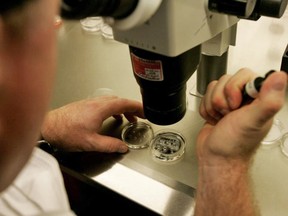Science
Scientists Transform Human Skin Cells into Fertilizable Eggs

Scientists achieved a significant breakthrough by converting human skin cells into fertilizable eggs in the laboratory for the first time. This development, announced on March 15, 2024, could eventually provide new reproductive options for infertile individuals, according to a U.S.-led team of researchers. While the technology is still in its infancy and years away from practical application, it offers hope to the one in six people affected by infertility globally.
The process, known as in-vitro gametogenesis (IVG), was detailed in a study published in the journal Nature Communications. Co-author Paula Amato, a researcher at the Oregon Health & Science University, explained that this method could allow older women or those who lack eggs for various reasons to have genetically related children. Additionally, it could enable same-sex couples to have children that share genetic ties to both partners.
The researchers utilized an innovative approach by first removing the nucleus from normal skin cells and transferring it into donor eggs that also had their nucleus removed. This technique, known as somatic cell nuclear transfer, previously facilitated the cloning of Dolly the sheep in 1996. A crucial hurdle was addressed during this process: skin cells contain 46 chromosomes, while eggs have only 23. To resolve this, the team developed a method called “mitomeiosis,” which mimics the natural division of cells, successfully creating 82 developing eggs, referred to as oocytes.
These oocytes were subsequently fertilized using sperm through in vitro fertilization (IVF). After six days, just under nine percent of the embryos reached a stage suitable for potential transfer to the uterus, a standard procedure in IVF. Despite the low success rate, the researchers noted that in natural reproduction, approximately one-third of embryos typically reach the “blastocyst” stage necessary for implantation.
Amato indicated that while promising, the technology is still at least a decade away from widespread availability. “The biggest hurdle is trying to achieve genetically normal eggs with the correct number and complement of chromosomes,” she stated.
The breakthrough has drawn praise from experts in reproductive medicine. Ying Cheong, a researcher at the University of Southampton in the UK, expressed enthusiasm for the findings, emphasizing the potential of using DNA from ordinary body cells to create viable eggs. “While this is still very early laboratory work, in the future it could transform how we understand infertility and miscarriage,” Cheong said, highlighting the broader implications for individuals facing reproductive challenges.
Other research teams are exploring different methods for generating eggs in laboratory settings, such as reprogramming skin cells into induced pluripotent stem cells, which can develop into various cell types, including eggs. Amato noted, “It’s too early to tell which method will be more successful. Either way, we are still many years away.”
The study adhered to existing ethical guidelines governing embryo research in the United States, ensuring responsible conduct in this groundbreaking area of science. As the research progresses, it holds the potential not only to redefine infertility but also to provide new avenues for those who currently have no viable options for parenthood.
-

 Politics4 weeks ago
Politics4 weeks agoSecwepemc First Nation Seeks Aboriginal Title Over Kamloops Area
-

 World5 months ago
World5 months agoScientists Unearth Ancient Antarctic Ice to Unlock Climate Secrets
-

 Entertainment5 months ago
Entertainment5 months agoTrump and McCormick to Announce $70 Billion Energy Investments
-

 Science5 months ago
Science5 months agoFour Astronauts Return to Earth After International Space Station Mission
-

 Lifestyle5 months ago
Lifestyle5 months agoTransLink Launches Food Truck Program to Boost Revenue in Vancouver
-

 Technology3 months ago
Technology3 months agoApple Notes Enhances Functionality with Markdown Support in macOS 26
-

 Lifestyle3 months ago
Lifestyle3 months agoManitoba’s Burger Champion Shines Again Amid Dining Innovations
-

 Top Stories2 months ago
Top Stories2 months agoUrgent Update: Fatal Crash on Highway 99 Claims Life of Pitt Meadows Man
-

 Politics4 months ago
Politics4 months agoUkrainian Tennis Star Elina Svitolina Faces Death Threats Online
-

 Sports5 months ago
Sports5 months agoSearch Underway for Missing Hunter Amid Hokkaido Bear Emergency
-

 Politics5 months ago
Politics5 months agoCarney Engages First Nations Leaders at Development Law Summit
-

 Technology5 months ago
Technology5 months agoFrosthaven Launches Early Access on July 31, 2025





















